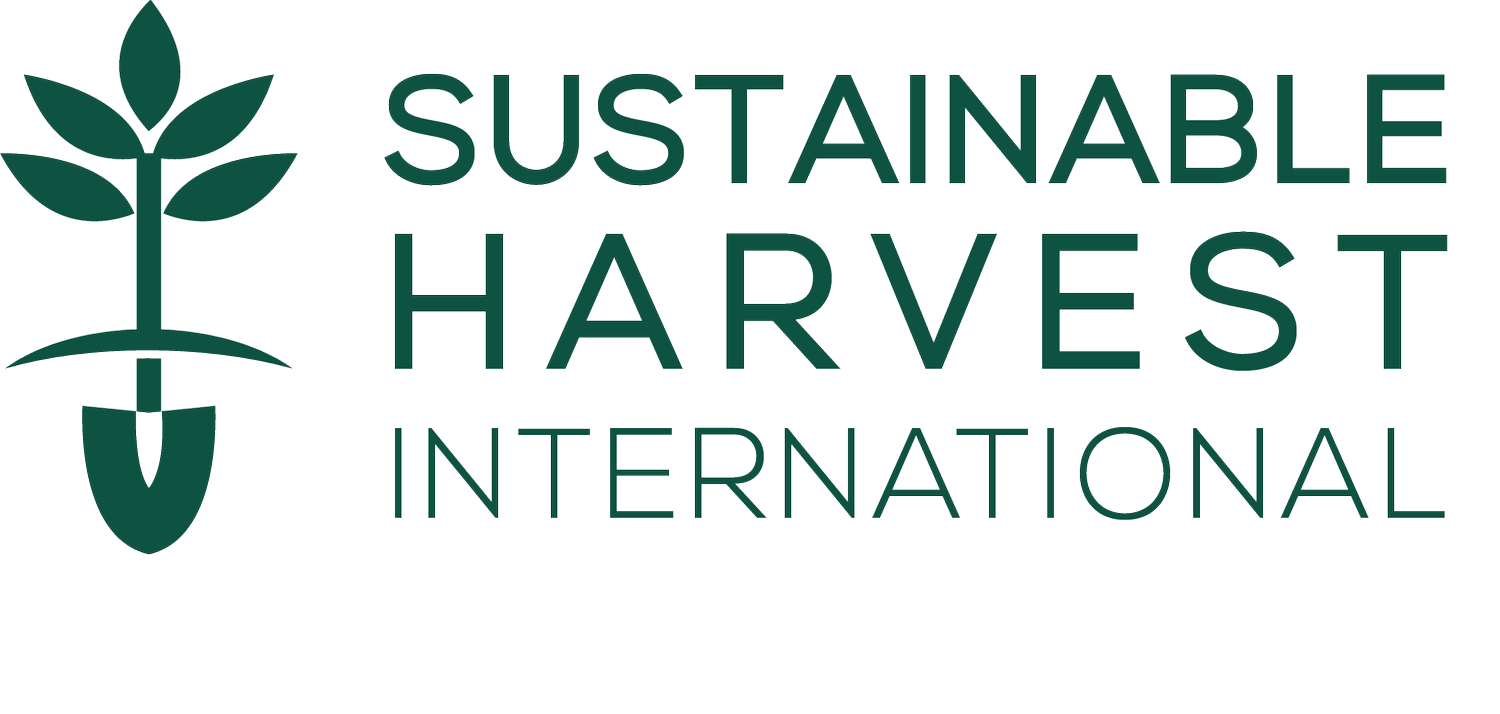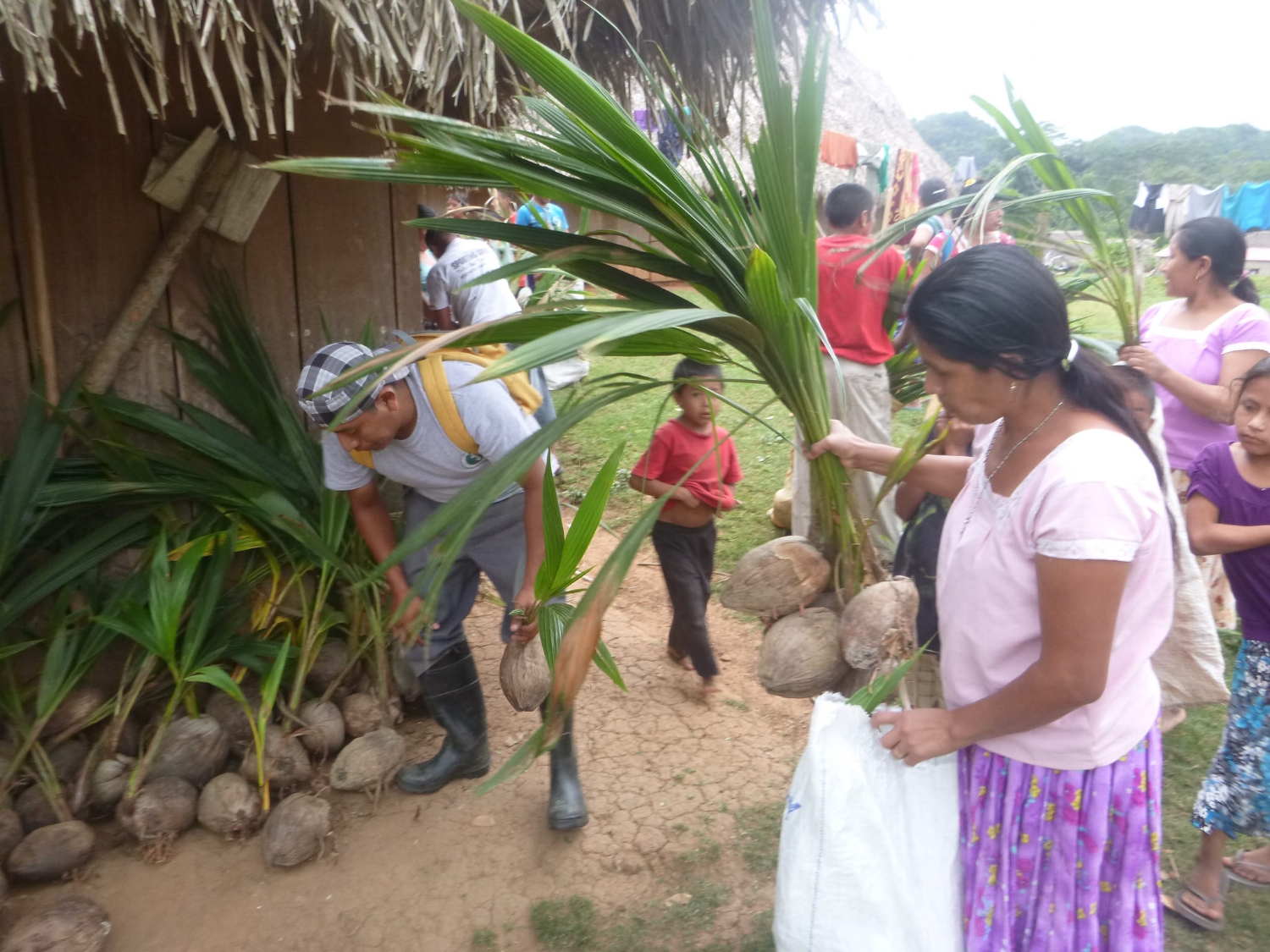Today we're headed to Belize to peek in on the building of a traditional Mayan house, and consider how Sustainable Harvest International fits into the bigger picture of farmers' lives in rural indigenous communities. Keep reading to see how Luciya Coc and Julian Acal put a roof over their heads!
Community members in Otoxha, Belize thatch the roof a new, traditionally built house - photo by Robin McCarthy
Perhaps you are like us: when we imagine carpenters building a home, our minds create a scene loud with the buzz of saws, compressors, and assorted other whirring and banging away to create a house from raw materials.
But this is not the case in Otoxha, a community in its second year of collaboration with Sustainable Harvest International-Belize. Otoxha’s residents are all Mayan, a common characteristic among families in our Belize program, which is compromised almost entirely of indigenous communities.
On a Saturday morning in Otoxha, over two dozen men are building a house in the diffused yellow light of a misty tropical morning. They’ve been at it since daybreak, and their work is nearly silent.
Thatched roofs in Otoxha and surrounding areas are made with limbs from Cajune palm trees - photo by Robin McCarthy.
The materials are modest: a pile of freshly cut cahune palm for the roof, a stack of long rails harvested from jungle trees, and rough-hewn boards of emory wood ready to become walls.
There are no saws, hammers or nails. Instead, a pile of dark machetes under an the overhang, abandoned out of the rain, and a community of men balancing on the beams and rafters of the house in progress, lashing materials into shape.
The only sounds are the brush of palm dragged across the grass, the muted tapping of rain, and easy conversation in Kekchi as men work.
The home in progress will belong to Julian Acal and his partner, Luciya Coc, and their children Jenny and Namar.
This house was not the product of your generous contributions to our mission. Not exactly. Sustainable Harvest International-Belize has been working with residents of Otoxha for over a year, but the community has been building their houses like this-- communally—for generations.
Jenny Acal and the new cacao trees her family is preparing to plant near their home - photo by Robin McCarthy
Your support allows us to work effectively within the collaborative way of life already in place here. It is donor support, committed field trainers and hard-working families that put the watermelons in the garden beside where Julian and Luciya‘s new home will soon stand. Donor support will nurture the small cacao nursery they are preparing to plant and protect (organically!) from Otoxha’s most destructive pest, the dreaded wee-wee ants.
It’s late June, and the rainy season has finally arrived, three weeks late. This isn’t a surprise to people in Otoxha, although it is notable. Farmers in Otoxha report that the seasons are becoming unpredictable, that each year it is harder to anticipate when the rain will come and how long it will last. The southern region of Belize has been experiencing dryer than usual conditions, which has produced withered cacao crops and caused farmers to hold off on planting corn.
In the busy kitchen of Luciya Coc, community members help make a mountain of tortillas to feed everyone who helps build the new home - photo by Robin McCarthy
While the men build outdoors, inside a nearby home, nearly a dozen women labor over lunch preparation. Luciya is clearly in charge, directing the movement of bodies around the kitchen as they press tortillas by hand and warm them on an open fire. She’s a serious-seeming woman, slow to smile and quick-moving.
The corn from Julian and Luciya’s farm, an hour walk from here into the bush, is carried to a communal corn mill and ground into meal, then carried back to the kitchen.
The women take turns patting a mixture of corn and water into thin disks on a table. Marybeth, a young woman from the house next door, pat a ball of dough into a perfect disc of a tortilla, then balance it on her palm as she makes her way to the hot metal surface of an open-hearth stove. Marybeth lays her tortilla on the stove top between two dozen others. She taps at the corn discs with her fingertips, flips a few, and then walks away, back to the table to prepare another as someone moves into the space she leaves vacant. They fill a five gallon bucket with corn tortillas, then start on another.
When we talk about the work Sustainable Harvest International does in Central America, we talk about families we partner with, more than individual farmers. And we don’t select individual farms for partnership, instead focusing on communities seeking to work together to change the way they farm, eat and live.
The value of community collaboration is built into our methodology. It’s also built into the way of life in Belizean indigenous communities. Land here is managed communally. People in Otoxha approach challenges as a group, whether it’s the fallout from decades of commercial logging, or the struggle to provide livelihoods for youth on family farms in the face of opportunities in industrial agriculture. The approach here is collaborative more often than not.
Many of the men who are building Julian and Luciya’s house have worked in nearby towns, some as builders. They are knowledgeable about modern construction methods, but they choose to gather materials from the jungle and build their homes collaboratively, just as their ancestors did, on land owned, managed and cared for collectively.
Rosa Acal portions pork into bowls. A large lunch follows a morning of house building - photo by Robin McCarthy
Back in the house, bowls are laid out on the floor as the men begin the final stages of lashing thatch to the new roof outside. An older woman, Rosa Acal, takes a seat low to the floor and begins portioning pork into bowls. As each bowl is filled, Luciya whisks it away and replaces it with an empty one.
Before long, men filter in, picking up bowls of pork soup and small stacks of tortillas now that the day’s work is complete. The rain has relented, and everyone finds a spot outdoors to eat lunch.
Field Trainer Julian Pop (left) distributes coconut seedlings to Luciya Coc in March 2015 - photo by Sharla McFadzean
Later that evening, a Sustainable Harvest International-Belize field trainer who lives in a nearby village, stops by to inquire how things are going in Otoxha. He’s the field trainer here, and he has worked with many of the families in the village, including Julian and Luciya, to start vegetable gardens near their houses and better protect their crops from pests.
The hiring and training of local field trainers is part of what sets Sustainable Harvest International apart from other organizations in this industry. Our field trainers aren’t outsiders trying to integrate into remote communities. This is their home, and donations to our programs support these professionals who are experts not just in organic farming, but also in the customs, language and culture that influence the families they work with.
Luciya Coc and her children, Jenny and Namar Acal, stand in their newly built house before the walls are up - Photo by Robin McCarthy
With all this talk about the role of the community in rural Belize, it would be a mistake to imagine that Sustainable Harvest International is operating alone in its quest for sustainable solutions in Otoxha. It’s a collective of generous foundations and donors like you who believe that sustainable farming can transform lives and restore forests that make all this collaborative, integrated success possible.
Curious about life in Otoxha? Check out Field Program Director Elliott Powell's post from a recent visit to this village here.










